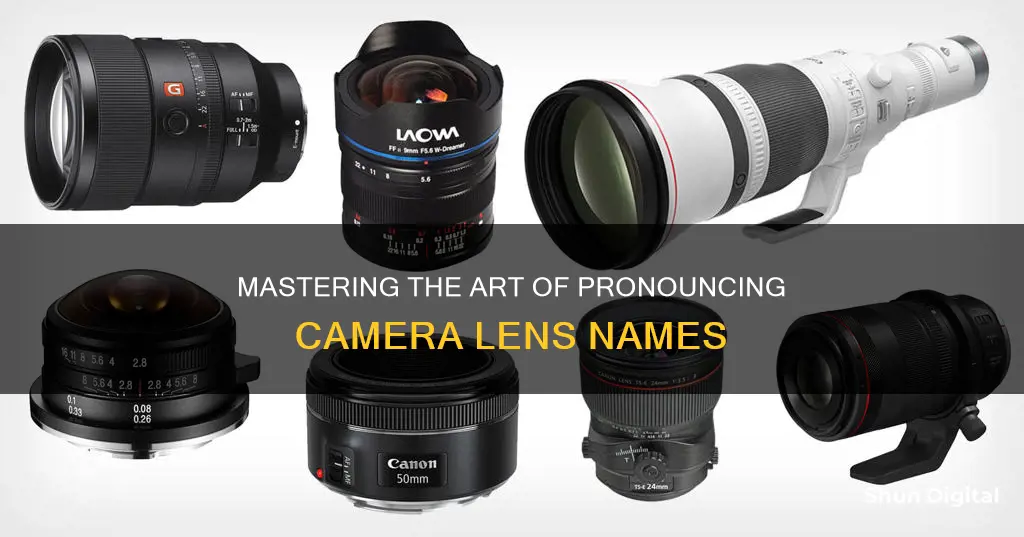
Camera lenses are full of abbreviations, number ranges, and advertising terms that can be confusing. However, understanding the lens name is essential for determining the lens's quality and finding the right one for your needs. The lens name typically includes the brand name, lens type, focal length in mm, maximum aperture, and other features/abbreviations. The focal length and maximum aperture (or f-number) are the most critical terms, as they directly impact the types of photos you can capture. A single focal length indicates a prime lens, while a range denotes a zoom lens. The f-number represents the lens's maximum aperture, with smaller values indicating a wider aperture and larger values indicating a narrower one. Other abbreviations may indicate specific features, such as image stabilization (IS, VR, OSS) or lens motor type (USM, SWM). Some terms are used for marketing purposes and may not provide significant additional information. It's important to understand the lens specifications and their impact on your photography to choose the right lens for your needs.
What You'll Learn

F-numbers represent aperture
F-numbers, also known as f-stops or f-ratios, represent the aperture of a camera lens. Aperture refers to the "pupil" of the camera lens, which can be adjusted to control the amount of light that passes through the lens to reach the camera sensor. The size of the aperture is denoted by a number preceded by "f/" or just "f" and followed by a number, e.g. f/4.5.
The relationship between f-numbers and aperture size can be confusing for beginners, as it is inverse. Smaller f-numbers represent larger apertures, which allow more light to pass through the lens, resulting in a brighter image. Conversely, larger f-numbers represent smaller apertures, which reduce the amount of light entering the lens and create a darker image.
The f-number is calculated by dividing the focal length of the lens by the diameter of the entrance pupil (effective aperture). This calculation takes into account the role of focal length, which is essential as light spreads out as it travels from its source. The f-number scale commonly used in photography includes the following values: 1, 1.4, 2, 2.8, 4, 5.6, 8, 11, 16, 22, and 32. The difference in exposure between adjacent numbers on this scale is one stop, meaning the amount of light passing through the lens is doubled or halved.
F-numbers are important in photography as they determine the depth of field, diffraction, and exposure of an image. A lower f-number results in a shallow depth of field, with a blurred background and sharp focus on the subject, which is desirable for portrait photography. A higher f-number provides a wider depth of field, with both foreground and background in focus, which is often used in landscape photography. Additionally, f-numbers affect the brightness of an image, with lower f-numbers resulting in brighter images and higher f-numbers leading to darker images.
Understanding Cameras: Convergent Lenses and Their Uses
You may want to see also

Focal length is measured in millimetres
Focal length is a measure of how strongly a lens converges or diverges light. It is the distance from the plane of the sensor to the optical centre or nodal point of the lens, and it determines the lens's angle of view. In other words, it's the distance at which a focused image is formed from parallel rays.
The focal length of a lens is usually specified in millimetres, but some older lenses are marked in centimetres (cm) or inches. The millimetre is a fine enough unit to specify all common focal lengths as whole numbers.
The focal length of your lens is shown in millimetres on the lens. For example, a lens stamped 1.8 / 50 has an f/1.8 max aperture and a 50mm focal length.
The focal length tells you the lens's field of view. The smaller the number, the wider the field of view. A lens with a 20mm focal length gives you a wide angle, while a 50mm lens is considered standard, and a 100mm focal length gives you a tighter, more magnified view.
Prime lenses have a fixed focal length, meaning there's no zoom function. A 50mm prime lens will have 50 or 50mm noted on the lens. Zoom lenses, on the other hand, have a variable focal length, with the limits of the range noted on the lens. For example, a zoom lens with a focal range of 70-200mm allows you to zoom from 70mm all the way up to 200mm.
The Myth of Camera Lenses: Curved Glasses Explained
You may want to see also

Lens mount systems
A lens mount is the interface between a camera body and a lens. It is a feature of camera systems that allow for interchangeable lenses, such as single-lens reflex cameras, single-lens mirrorless cameras, and rangefinder cameras. Lens mounts are also used in optical laboratory prototyping, where modular components are joined via C-mount or T-mount elements.
Lens mounts can be categorised into three types: screw-threaded, bayonet, and breech-lock (friction lock). Modern camera lens mounts are of the bayonet type, as this mechanism precisely aligns the mechanical and electrical features between the lens and the body. Screw-threaded mounts, on the other hand, are fragile and do not align the lens in a reliable rotational position. Bayonet mounts use three to four tabs to lock a lens in place. The lens is aligned with a marked section on the camera body, twisted, and locked into place with a spring-loaded pin.
Different camera manufacturers (such as Sony, Nikon, and Canon) have different lens mount systems, which are usually incompatible with each other. This incompatibility is often attributed to manufacturers' desire to "lock in" consumers to their brand.
- EF-Mount (Electronic Focus) - Canon
- PL-Mount (Positive Lock) - Arri and RED cinematography cameras
- F-Mount (Format Single-Lens Reflex) - Nikon
- A-Mount (Sony ‘Alpha’ Series)
- E-Mount (Sony Mirrorless)
- Z-Mount (New Nikon Mirrorless)
- RF-Mount (New Canon EOS Mount)
- M43-Mount (Micro Four Thirds) - Blackmagic, Panasonic, and Olympus
Lenses for Full-Frame Cameras: What's the Difference?
You may want to see also

Focusing distance in meters and feet
Camera lenses have a minimum focusing distance beyond which they cannot focus on a subject. This distance is usually indicated on the front side of the lens in meters (m) and feet (ft). For example, a lens that shows 0.9m / 2.96ft as its minimum focusing distance can focus on any subject beyond 0.9 meters or 2.96 feet.
The minimum focusing distance is important for photographers who want to get close to their subjects, such as when taking close-up photos of flowers. In such cases, photographers can start by getting extremely close to the subject and then gradually move away until the subject is in focus.
Zoom lenses may have a range of numbers indicating the minimum focusing distance, as the distance can vary depending on the focal length. For example, a reading of 0.5m / 1.64ft - 0.8m / 2.63ft means that as the lens zooms in, the minimum focusing distance increases. So, at the widest focal length, the focusing distance is 0.5 meters, but when zoomed in, the distance becomes 0.8 meters.
Prime lenses, on the other hand, have a fixed focal length and, therefore, a constant minimum focusing distance.
It is worth noting that the minimum focusing distance is different from hyperfocal distance, which is the focusing distance that gives your photos the greatest depth of field. Hyperfocal distance is important when you want to have both foreground and background elements appear sharp in your photograph.
Understanding Camera Lenses: A Beginner's Guide to Reading Them
You may want to see also

Image stabilisation
There are two types of image stabilisation: lens-based and in-camera. Lens-based stabilisation uses a floating lens element that is electronically controlled to counteract any camera shake. In-camera systems, on the other hand, physically shift the image sensor to compensate for movement.
Lens-based stabilisation tends to perform more smoothly with longer focal length lenses, but it adds to the cost of the lens. In-camera stabilisation, on the other hand, works with any lens you mount on the camera and is more affordable. However, it is less effective with longer focal lengths.
Some common acronyms used to denote image stabilisation include:
- IS (Image Stabilisation) - Canon, Olympus
- VR (Vibration Reduction) - Nikon
- OSS (Optical SteadyShot) - Sony
- OIS (Optical Image Stabilisation) - Fujifilm
- OS (Optical Stabilisation) - Sigma
- VC (Vibration Compensation) - Tamron
- SR (Shake Reduction) - Pentax
It is important to note that image stabilisation should typically be turned off when using a tripod, as it can create a feedback loop and introduce blurriness. Additionally, it can drain battery life, so it may be advisable to turn it off in certain situations to conserve power.
Sunlight and Camera Lenses: Friends or Foes?
You may want to see also
Frequently asked questions
Camera lens names are full of abbreviations, number ranges, and advertising terms. The most important terms are focal length and maximum aperture, or the "mm" and "f/number" terms. These numbers relate most directly to the types of photos you will be able to capture with the lens.
The focal length of a lens is written in millimeters (mm) and indicates how far "zoomed in" the lens is. A range of focal lengths indicates a zoom lens, while a single number indicates a prime or single-focus lens. The maximum aperture, or "f/number", indicates the size of the aperture, with a wider aperture allowing more light in and giving you better depth of field control.
The letters in lens names indicate the lens type, features, and compatibility. For example, "FE" denotes a lens compatible with a camera with a 35mm full-frame image sensor, while "OSS" denotes an in-lens optical camera-shake compensation function. Letters can also indicate a higher-quality lens line, such as "L" for Canon lenses.







